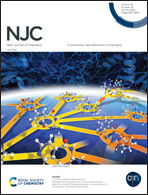Bio-fabricated ZnO nanoparticles: direct sunlight-driven selective photodegradation, antibacterial activity, and thermoluminescence-emission characteristics
Abstract
Zinc oxide (ZnO) nanoparticles were prepared via a Gliricidia sepium leaf extract-assisted green synthetic route. Near-spherical and elongated nanoparticles were obtained according to morphology analysis. The sample was investigated for photodegradation of different organic dyes under ultraviolet (UV) and direct-sunlight irradiation. Degradation was selective towards a cationic dye (methylene blue) and the catalyst remained inactive towards an anionic dye (methyl orange). Complete removal of methylene blue from its aqueous solution occurred within 35 min under direct sunlight whereas, under UV light, the catalyst was less efficient. The optical bandgap was determined to be 3.13 eV and the sample bore a negative surface charge (−36.74 eV). As an appendage for water treatment, the antibacterial activity of the sample towards Klebsiella pneumoniae and Staphylococcus aureus was monitored. Our study unveiled the thermoluminescence property of the material upon exposure to gamma radiation.



 Please wait while we load your content...
Please wait while we load your content...